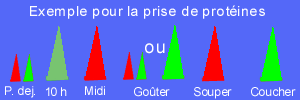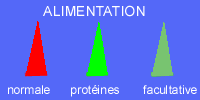|
Proteins are not doping substances.
|
When you make a physical effort:
You start by not having enough air, so you breathe more.
You sweat, so you drink.
You burn energy, so you eat pasta, potatoes, rice and sugar.
You also damage your muscle, so you must rebuild.
The muscle weight after training
is less than when you started!
You may be stronger if you are fatter, this still has to be proved.
Although the fat cells no longer multiply after the age of 15 , they can nevertheless develop considerably.
To lose weight, simply choose between the drastic diets and liposuction.
So avoid making fat to convert it later on into muscle, since lipids are never converted into proteins.
Do not forget that excess fat damages the veins and arteries and tires the heart.
When should proteins be taken
during the day. |
 |
Explanation of the previous table.
Large triangle = 30 - 35 g of proteins 80/90 %
Small triangle = 15 - 20 g of proteins 80 /90 %
|
 |
Also visit two links which provide useful information on proteins in everyday life:
Before indulging in a frantic race to consume powders, find out whether there are already enough proteins in your plate!
And finally, one last little click HERE.
|
TOP OF PAGE.
|
|